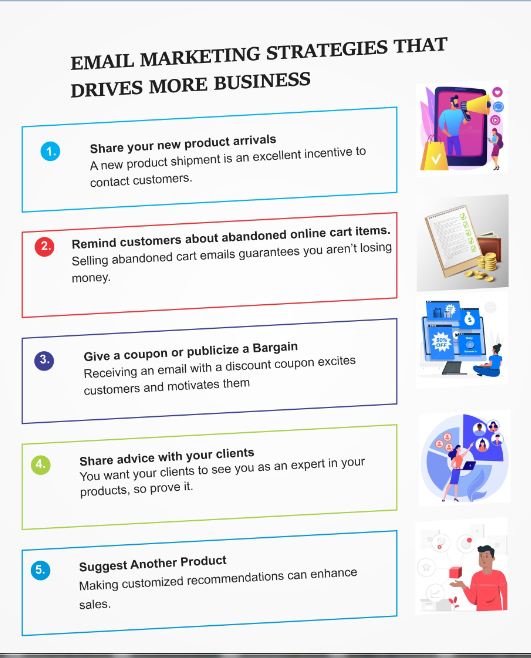Email marketing works wonders. According to the UK-based Data & Marketing Association, email marketing returns between $30 and $50 for every dollar spent. Emails that customers find useful and interesting keep them interested and subscribed to your list.
While sales are generally the goal of email marketing, creating relationships with clients can lead to many sales over time. Each email should have a clear aim that builds trust while driving sales through website clicks and product views.
- Creating effective email marketing takes planning and design
- Here are five email marketing strategies to boost sales
- Share your new product arrivals
- Remind customers about abandoned online cart items
- Give a coupon or publicize a bargain
- Share advice with your clients
- Suggest another product
Creating effective email marketing takes planning and design
Tips for creating client emails:
- Use a compelling subject line to enhance email open rates.
- Send emails with relevant graphics.
- Professionalise your design.
- Condense text.
- Review your email with a wide internal audience.
- Track sales and purchases to see which emails work best.
- Encourage recipients to visit the website, download a report, or phone a representative in each email.
The most significant factors are your message and email format. Provide a reason for customers to open and read your emails, then visit your website.
Here are five email marketing strategies to boost sales
The different 5 email marketing strategies you can use to boost your sales are:
1. Share your new product arrivals
A new product shipment is an excellent incentive to contact customers. Informing both new and returning clients about your latest arrivals helps increase website traffic. Take advantage of your regular shipments by sending out a weekly email showcasing your latest items. This provides your subscribers something to look forward to every week.
- Consider a theme for each new product email, such as “Holiday Baking” or “Skiing Ready.”
- Use images of the products in use. Making handmade banana bread for a holiday gathering or sharing it with family for a nice morning helps people visualize your goods.
- Limit the number of new products to seven. More than seven can be daunting.
- Include easy-to-find product links to boost website traffic.
2. Remind customers about abandoned online cart items
Sending abandoned cart emails guarantees you aren’t losing money. These emails are delivered when a visitor leaves your website without purchasing an item. This form of communication reminds you to buy the product. Busy or distracted people sometimes forget to complete transactions they intended to make.
- Make a catchy subject. Forget Something? is a suitable topic line in a pinch.
- Include a large image and a brief product description.
- Keep it short.
- Include a “Buy Now” button in the email to boost purchases.
3. Give a coupon or publicize a bargain.
Everyone loves a good sale. Receiving an email with a discount code or coupon excites customers and motivates them to buy now. Consider a holiday or end-of-season theme for your sale mailings.
- Announce the sale in the subject line
- Always use product photographs.
- Announce the discount in huge font.
- Include a link to your website’s sale section for online sales.
4. Share advice with your clients
You want your clients to see you as an expert in your products, so prove it. Sending emails that don’t immediately promote your products or services can help you create trust with your customers and increase sales.
Uncertainty over pyrotechnics can be reduced by a pet sitter, for example. A landscaper may give weed-control tips. The options are unlimited. You may believe that educating your customers part of your job devalues you. Your value to them increases as a result of demonstrating your expertise in your field.
- Create a subject line that addresses current consumer issues.
- Keep the tip text short and sweet.
- Include a link to your blog if it elaborates on the tip.
- Limit product mentions to two.
- Link to a related conversation on your Facebook page so your consumers may spread the word. Consider who they share with as prospective new clients.
- Encourage your clients to contact you for further information.
- Include a clear CTA to the website and relevant product pages.
5. Suggest another product
Making customised recommendations can enhance sales. A follow-up email to a consumer who recently bought plants could mention popular gardening tools. Your customers will feel that you understand their demands when you inform them about suitable products. Assure the products you recommend are suitable. Recommending products that don’t make sense to the buyer can damage trust.
- Include a clear snapshot of the suggested item.
- Clearly identify why you are sending the email, such as “We hope your new plants look beautiful in your garden,” for example. These gadgets will save you time (and knees).”
- Include a link to the product on your website to make the customer’s purchase as simple as feasible.
Because email is so common, it’s easy to miss the influence smart communications can have on your consumers. Your emails should strike a balance between connection development and generating traffic to your website. Your customers will look forward to receiving your emails if you carefully design them and plan your strategy.

